Keeping your home safe and secure is very important. With more home break-ins happening, getting a good home security system is essential. This guide will help you set up a home security system. It will give you the confidence to keep your family and property safe.
If you want to make your home safer, knowing about security systems is key. You can learn more about buying and setting up a system on Family Handyman. A good security system keeps intruders away and gives you peace of mind.
Key Takeaways
- Understand the components of a complete home security system.
- Learn how to pick the right security system for your home.
- Discover the benefits of DIY home security systems.
- Find out how to place security sensors for the best effect.
- Understand the importance of monitoring services.
Understanding Home Security Needs and Risks
Knowing your home’s security needs is key to a good security plan. You need to check your property’s weak spots, find where intruders might get in, and know about common threats in homes.
Assessing Your Property’s Vulnerabilities
Start by checking your property well. Look for weak spots like old doors, broken windows, or dark areas. You might want to get a pro to spot things you miss. For more on home security, check out https://solarkiit.com/2025/05/03/home-security/.
Identifying Entry Points and Security Weaknesses
Doors, windows, and garages are common spots for intruders. Make sure these are strong by using tough doors, locks, and window film. Check them often to find any weak spots.
Common Security Threats in Residential Areas
Homes face threats like burglary, vandalism, and identity theft. Knowing these dangers helps you act early. A security pro says, “Knowing your threats is the first step to a good security plan.”
“The first step in securing your home is understanding the risks it faces and taking proactive measures to mitigate those risks.”
| Security Threat | Prevention Measure |
|---|---|
| Burglary | Reinforced doors and security systems |
| Vandalism | Security cameras and outdoor lighting |
| Identity Theft | Secure mailboxes and document shredding |
Types of Home Security Systems Available Today
Homeowners have many security systems to choose from. These systems vary based on property size, budget, and security needs.
Wired vs. Wireless Security Systems
Choosing between wired and wireless systems is key. Wired systems are reliable but cost more and are harder to install. Wireless systems are easier to set up and more flexible, making them popular.
Monitored vs. Unmonitored Systems
Deciding on monitored or unmonitored systems is important. Monitored systems alert authorities in emergencies. For more on monitored systems, check CNET’s guide. Unmonitored systems are cheaper but require homeowners to respond to alerts.
Smart Security Systems and Traditional Options
Smart home tech has brought smart security systems that can be controlled remotely. Traditional systems are effective but lack the advanced features of smart systems.
Popular Security System Brands and Their Features
Many brands offer home security systems. ADT is known for its wide range of security solutions. Learn more about ADT on Solarkiit’s review. Other brands like Ring, Nest, and Vivint also offer unique features.
When picking a security system, think about your needs and compare options. The many systems available today meet different needs, ensuring homeowners find the right fit for their lifestyle and budget.
Essential Components of a Complete Home Security System
A home security system works best when all parts work together. It keeps intruders away and gives homeowners peace of mind. Knowing what each part does is key to choosing the right home security system.
Control Panels and Hubs
The control panel or hub is the system’s brain. It talks to all parts and lets you turn the system on or off. Today’s panels have touch screens and can be controlled from your phone.
Door and Window Sensors
These sensors alert you if someone opens a door or window. They’re a must-have for any system. For more on how they work, check out security systems.
Motion Detectors and Cameras
Motion detectors spot movement inside your home and set off alarms. Cameras watch over your place, scaring off intruders and helping catch them. New cameras have night vision and can follow movement.
Alarms, Sirens, and Notification Systems
Alarms and sirens scare off intruders and warn neighbors and you. Notification systems keep you updated on system events. This way, you always know what’s happening.
| Component | Function | Benefits |
|---|---|---|
| Control Panel/Hub | Central control and communication | Easy system management, remote access |
| Door/Window Sensors | Detects openings and breaches | Immediate intrusion alerts, enhanced security |
| Motion Detectors/Cameras | Identifies movement and provides surveillance | Visual deterrent, aids in identification |
| Alarms/Sirens | Alerts to possible breaches | Deters intruders, alerts homeowners and neighbors |
Knowing and using these key parts helps make a strong secure home technology system. When thinking about the home security system installation cost, remember the long-term safety and peace of mind it brings.
Planning Your Home Security System Layout
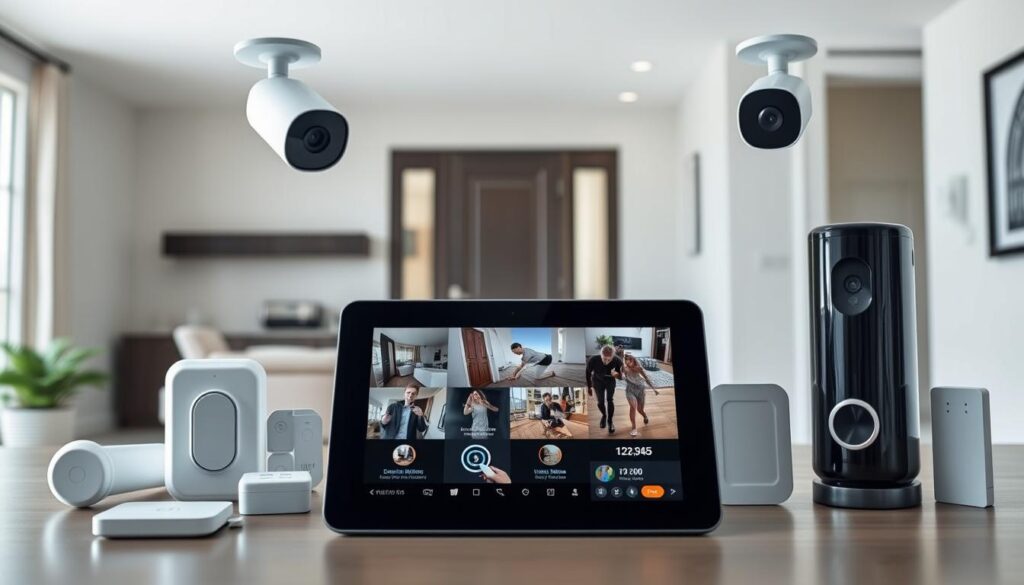
Creating a strong home security layout means knowing your home’s security needs. A good security system works only if it’s set up right.
Creating a Floor Plan with Security Zones
First, make a detailed floor plan of your home. Split it into security zones. This could be different floors, garages, or areas with valuable things. Identifying these zones helps in strategically placing security devices.
Optimal Placement for Sensors and Cameras
Sensors and cameras are key parts of a home security system. Door and window sensors should be placed on all entry points. Motion detectors can cover big areas or specific paths. Cameras should be at spots like front doors, backyards, or garages. The goal is to cover everything without missing any spots.
Coverage Considerations for Different Home Sizes
The size of your home affects how many devices you need. Bigger homes need more sensors, cameras, and control panels. Smaller homes or apartments might need a simpler setup. Assessing your home’s size and layout is key to finding the right security system size.
By planning your home security system’s layout well, you can get a smart home security setup. This setup will help keep intruders away and protect your property.
DIY vs. Professional Installation: Pros and Cons
There are two ways to install a home security system: DIY or professional installation. Each has its own benefits and drawbacks. Homeowners need to think about several things before making a choice.
Benefits and Limitations of Self-Installation
DIY installation can save money on labor and lets you work at your own pace. But, it needs technical skills and can take a lot of time. If done wrong, it might not work right or as well as expected.
Key benefits of DIY installation:
- Cost savings on labor
- Flexibility in installation timing
- Personal control over the installation process
When to Consider Professional Installation Services
Go for professional installation if your system is complex or if you’re not tech-savvy. Experts can make sure it’s set up right and works as it should.
For a detailed look at costs, check out this article on CNET. It compares DIY and professional installation costs.
Cost Comparison Between DIY and Professional Options
The cost to install a home security system differs a lot between DIY and professional setups. Here’s a quick comparison:
| Installation Type | Average Cost | Includes |
|---|---|---|
| DIY Installation | $200 – $500 | Equipment costs, personal time |
| Professional Installation | $500 – $1,500 | Equipment, labor, warranty, monitoring services |
Choosing between DIY and professional installation depends on your comfort with tech, budget, and security needs. Weighing the pros and cons helps homeowners make the best choice for them.
Tools and Materials Needed to Install Security System at Home
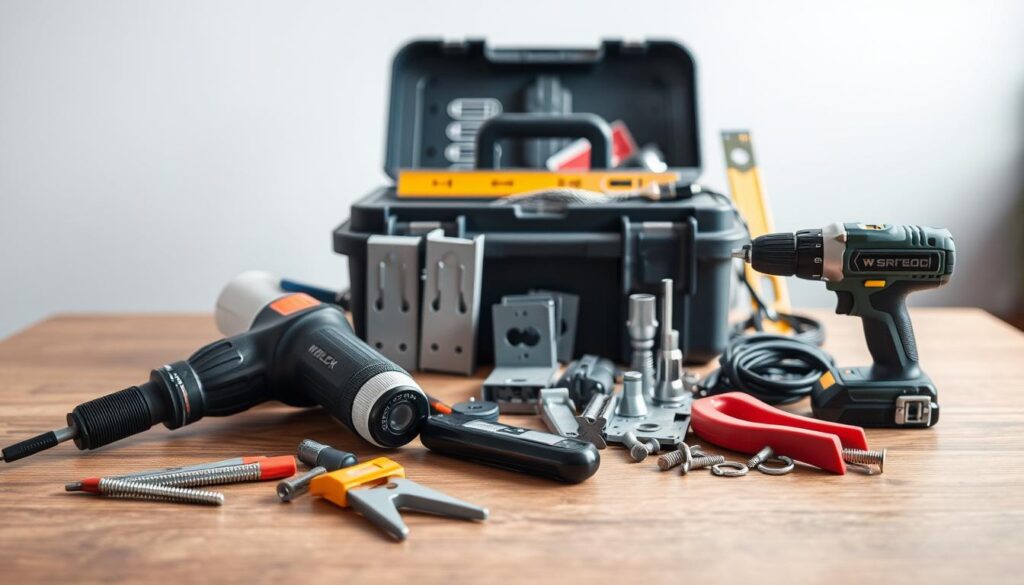
Having a secure home starts with the right tools for installing a security system. Before you begin, make sure you have all the necessary equipment. This will make the installation process smooth and efficient.
Basic Tools for DIY Installation
For a DIY home security setup, you’ll need some basic tools. You’ll need a drill, screwdrivers, and wire strippers. These tools will help you secure sensors and cameras and manage wiring.
Additional Equipment for Complex Setups
More complex setups might need extra tools like sensors, longer cables, or advanced control panels. For help with these, check out DIY resources. They offer valuable tips and insights.
Safety Equipment and Precautions
Always prioritize safety during installation. Wear safety goggles and gloves to protect yourself. Also, follow the manufacturer’s instructions for each part to avoid damage or malfunction.
Preparing Your Home Before Installation
Starting a DIY security system needs careful preparation. Before you begin, there are steps to take for a smooth setup. This ensures your system works well.
Cleaning and Clearing Installation Areas
Clear the spots where you’ll install your security gear. Get rid of any clutter or things that might block the setup. This helps your system work right.
Ensuring Proper Power Sources
Make sure you have enough power for your devices. If they need batteries, have the right ones ready. For plugged-in devices, check you have outlets nearby.
Internet and Wi-Fi Requirements
Smart systems need a strong internet connection. Check your Wi-Fi is strong enough for your new devices. For more help, see this guide.
| Preparation Task | Description | Importance Level |
|---|---|---|
| Clearing Installation Areas | Remove clutter and obstacles | High |
| Checking Power Sources | Ensure adequate batteries or outlets | High |
| Internet and Wi-Fi Check | Ensure a stable internet connection | High |
Step-by-Step Guide to Installing a Control Panel/Hub
The control panel is the heart of your home security system. It needs to be installed carefully for it to work right. A professional security system installation makes sure it’s done correctly.
Choosing the Optimal Location
Choosing the right spot for your control panel is key. It should be in a central, easy-to-reach spot, like near your home’s main entrance. Stay away from damp or very hot places.
Power and Internet Connection Requirements
Make sure the spot has a steady power source and is close to your internet router. A wired internet is safer than Wi-Fi. But if you use Wi-Fi, make sure it’s encrypted.
Wall Mounting Procedures
To mount your control panel on the wall, first mark the screw holes on the wall with the panel as a guide. Drill the holes, add wall anchors if needed, and screw it in. Make sure it’s straight and secure.
Programming and Initial Setup Process
After mounting, start the setup. This means following the maker’s guide to set up user codes, alarm settings, and connect it with other security gear. A professional security system installation makes this easier, making sure your system fits your home’s security needs.
Security experts say, “A well-installed control panel is the base of a good home security system.” Right installation and setup are key for your security system’s success.
Installing Door and Window Sensors Correctly
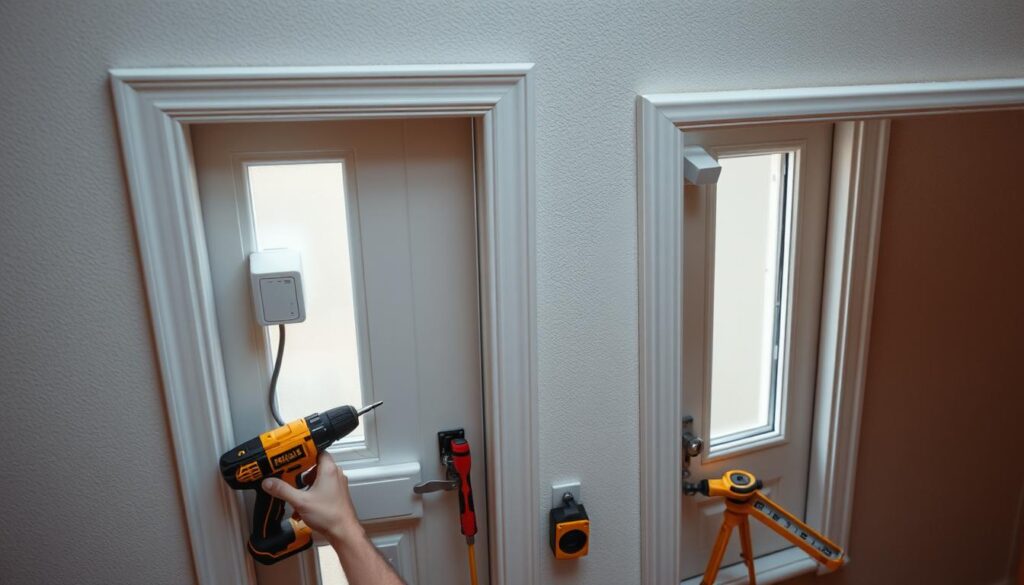
Door and window sensors are key in home security. They must be installed right to work well. These sensors are part of the best home security systems. They send alerts in real-time and keep intruders away.
Measuring and Positioning Sensors
Start by measuring and placing sensors correctly. First, find all entry points in your home. This includes doors and windows. Measure their width to pick the right sensor size.
Place sensors on the frame and the door or window itself. Make sure they line up when closed.
Securing Sensors to Different Materials
Installation varies based on the material. Wooden doors and windows use screws. Metal frames might need adhesive-backed sensors or magnetic ones.
For vinyl or aluminum, adhesive sensors work well. But make sure the surface is clean and dry for a strong bond.
Connecting Sensors to Your Control Panel
After installing, connect sensors to your control panel. Follow the maker’s guide for wiring or pairing wireless sensors. You’ll assign each sensor to a zone in your system.
Testing Sensor Functionality and Range
Test each sensor to make sure it works. Open and close doors and windows to see if the sensor triggers the right response. Check the signal strength and range for reliable communication.
- Verify that each sensor is detected by the control panel.
- Test the response time and accuracy of the sensors.
- Adjust sensor positioning if necessary to optimize performance.
By following these steps, you’ll ensure your sensors are installed right. This boosts your home security system’s effectiveness.
Setting Up Motion Detectors and Security Cameras
A good home security system needs smart placement of motion detectors and cameras. They work together to cover your home well and scare off intruders.
Strategic Placement for Maximum Coverage
It’s important to put motion detectors and cameras in the right spots. Motion detectors go in hallways, stairways, and by doors. Cameras should see faces and license plates, often at the front door and driveways.
Avoiding False Alarms with Proper Positioning
Right placement of motion detectors stops false alarms. Keep them away from vents, windows, and pet paths. If you have pets, use special motion detectors that ignore them.
Wiring or Battery Installation Procedures
Choose between wired or battery-powered devices for your security setup. Wired ones need a direct electrical connection, but installation is harder. Battery-powered ones are simpler to install but need battery checks often. For help with installation, check security camera installation guides.
Camera Angle and Field of View Optimization
Getting the right angle and view for your cameras is key. They should see as much as possible while keeping images clear. Use adjustable lenses or mounts for the best view.
Setting Up Video Storage and Recording Options
After installing cameras, set up how you’ll store and record video. Many cameras use cloud storage, while others use local devices like DVRs or NVRs. Think about storage space, video quality, and access to footage. For more on advanced recording features, visit home security companies.
Integrating Your Security System with Smart Home Devices
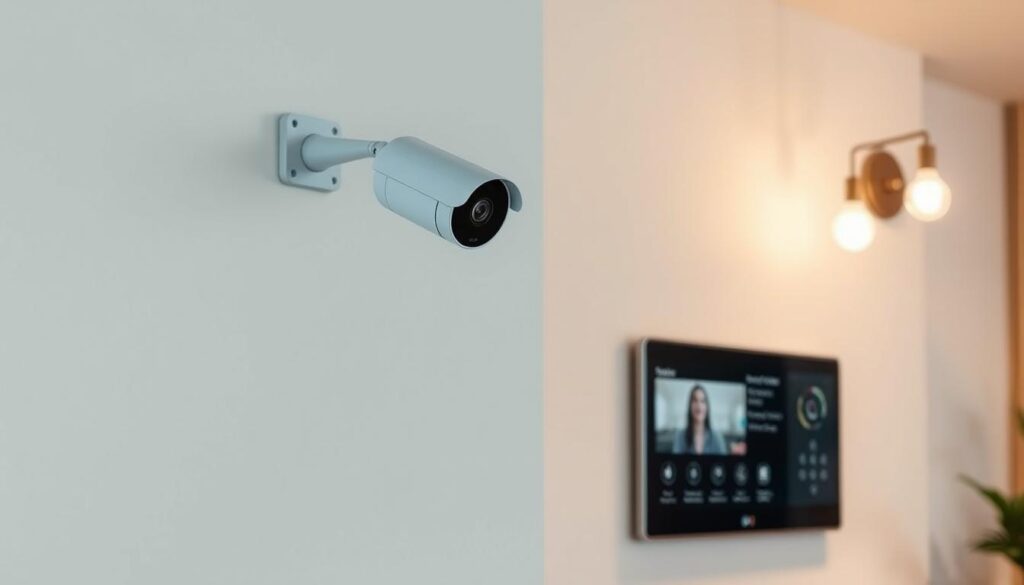
Connecting your home security system with smart home devices makes your home safer and more convenient. This link lets you manage your home’s security and smart devices more easily.
Compatible Smart Home Platforms
Many home security systems work with popular smart home platforms like Amazon Alexa, Google Assistant, and Apple HomeKit. These platforms make it easy to control smart devices, including cameras, door locks, and thermostats. For example, you can use voice commands to arm or disarm your security system or change your home’s temperature.
Voice Control and Automation Options
Voice control lets you manage your security system and other smart devices with voice commands. It’s great for those with mobility issues or who like hands-free control. Automation options let you create custom routines, like locking doors or turning on lights when your security system is on.
Remote Access and Mobile App Setup
Remote access lets you check and control your security system from anywhere with a mobile app. It’s key for getting alerts, watching live footage, and changing your security settings from afar. To use remote access, download your security system’s mobile app and follow the setup steps.
Creating Security Automation Routines
Automation routines make your home’s security more responsive and adaptable. For instance, you can set lights to turn on when motion is detected or send alerts to family members in emergencies. To learn more about setting up effective security systems, check out top-rated alarm systems.
By linking your security system with smart home devices, you make your home more secure, convenient, and connected. As smart home tech advances, so will the ways to boost home security.
Testing Your Newly Installed Security System
A new security system needs a full test to work right. This means checking each part, doing big tests, and fixing any problems.
Component-by-Component Testing Protocol
Start by testing each part of your system one by one. Make sure door and window sensors work when doors or windows open. Also, check that motion detectors catch movement where they should.
For cameras, see if they take clear pictures and don’t miss anything. This is important for your home’s safety.
System-Wide Tests and Simulated Breaches
Once you’ve checked each part, do big tests. Try to get in through doors or windows to see if alarms go off. Also, make sure the system sends alerts when it should.
For even better security, think about getting help from residential security system installation services. They can watch over your system for you.
Troubleshooting Common Installation Issues
If you find problems during testing, look at the troubleshooting guide. Issues like sensors not working, cameras not recording, or control panels not responding are common. Here’s a table with some fixes.
| Issue | Potential Cause | Solution |
|---|---|---|
| Sensor not triggering | Battery dead or misaligned | Replace battery or realign sensor |
| Camera not recording | Storage full or incorrect settings | Clear storage or adjust settings |
| Control panel unresponsive | Power issue or software glitch | Check power source or restart panel |
Testing and fixing your system well means it works right. This gives you peace of mind and makes your home safer.
Common Mistakes to Avoid During Installation
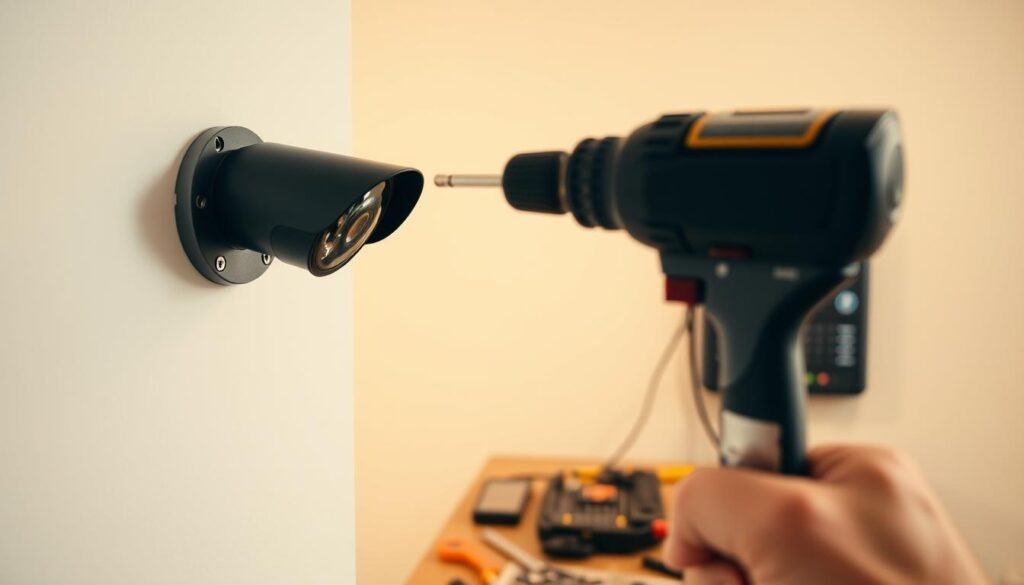
To make sure your home security system works right, avoid common mistakes during installation. A well-set-up system is your main defense against threats. Staying away from common errors is essential for its success.
Sensor Placement Errors
Getting sensors right is key in home security setup. Wrong placement can cause false alarms or leave your home open to intruders. For example, sensors too close to edges might not cover enough area.
To fix this, follow the maker’s guide for sensor placement. Think about your home’s layout too.
Network Configuration Problems
Your home security system’s strength depends on its network setup. Bad network setup can cause signal drops, failed alerts, and system inefficiency. Make sure your router is set up right and your system is on a stable network.
| Network Configuration Tips | Description |
|---|---|
| Use a Strong Password | Keep your network safe from unauthorized access. |
| Enable WPA2 Encryption | Lock your network with the latest encryption. |
| Regularly Update Router Firmware | Keep your network secure with the latest updates. |
Power Supply Oversights
A good power supply is vital for your security system. Not enough backup power can make your system weak during power outages. Make sure your system has enough backup power, like batteries, and check them often.
Coverage Gaps and Blind Spots
Even with a good security system, coverage gaps can happen if not planned well. Check your home’s layout to find blind spots. Place cameras and motion detectors smartly to cover all areas.
Knowing these common mistakes and avoiding them will help your home security system work right. This gives you peace of mind and better security.
Maintenance and Monitoring Best Practices
Keeping your home security system in good shape is key. A well-kept system keeps you safe and stops security issues.
Weekly and Monthly Maintenance Tasks
To keep your system running smoothly, do these tasks:
- Check all sensors and detectors weekly to ensure they are clean and functioning correctly.
- Test your system’s alarm and notification features monthly.
- Verify that all cameras are providing clear footage and are positioned correctly.
Battery Replacement Schedules
For a DIY security system setup, watch your battery levels. Replace batteries in sensors and detectors every 6-12 months, as the maker suggests.
Software Updates and System Upgrades
Keeping your system’s software up to date is critical. Enable automatic updates if you can. Or, check for updates manually every few months. Also, think about upgrading your system every 5-7 years to get the latest tech and features.
Professional Monitoring Options and Costs
If you chose a professional security system installation, think about professional monitoring. It offers 24/7 watch and quick action on security issues. Prices vary, but expect to pay $10-$30 a month.
By sticking to these maintenance and monitoring tips, your home security system will stay effective and reliable. This gives you peace of mind for many years.
Conclusion: Ensuring Long-Term Home Protection
A good home security system is key for long-term safety. Knowing your home’s security needs helps you choose the best systems. This ensures your home is well-protected.
Home security technology has improved a lot. It now includes advanced features and smart connections. These add to your home’s safety, covering doors, windows, and more.
Keeping your security system in top shape is important. Check batteries, update software, and test it often. This keeps your home safe and secure.
Getting a quality security system is a smart choice for homeowners. It gives you peace of mind, knowing your home and family are safe. Follow the tips in this article to make your home a safe haven.




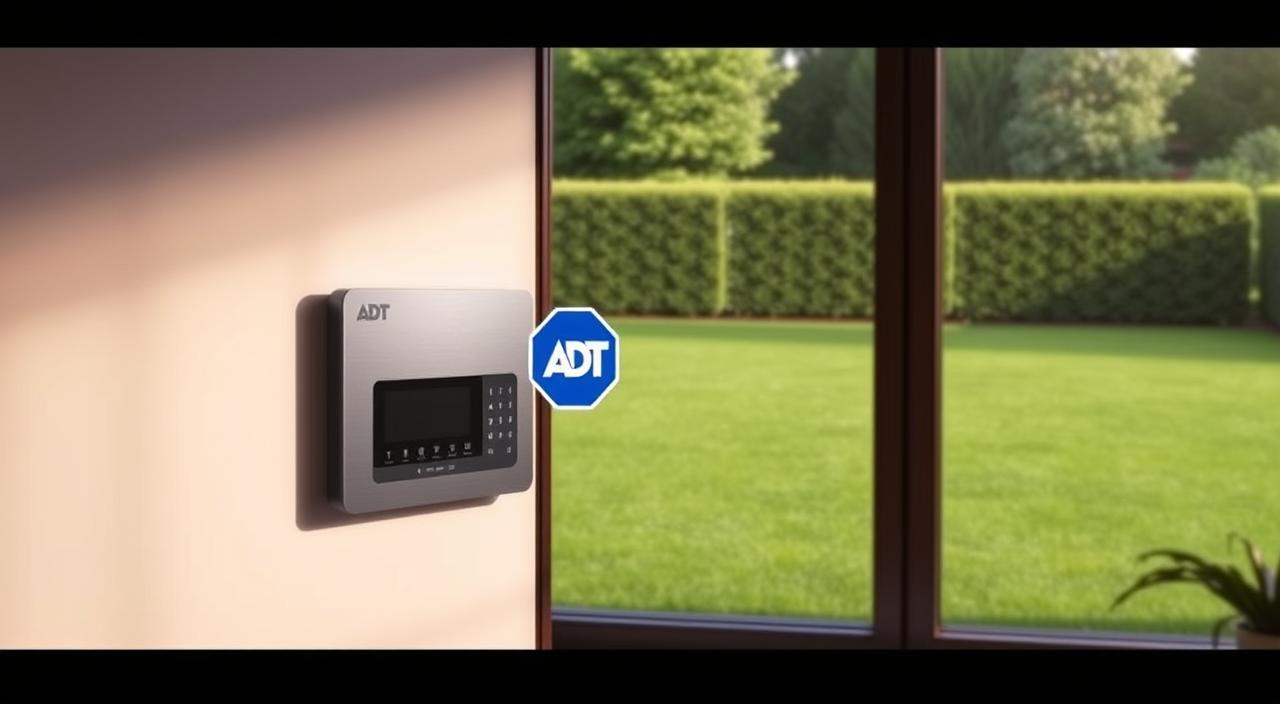
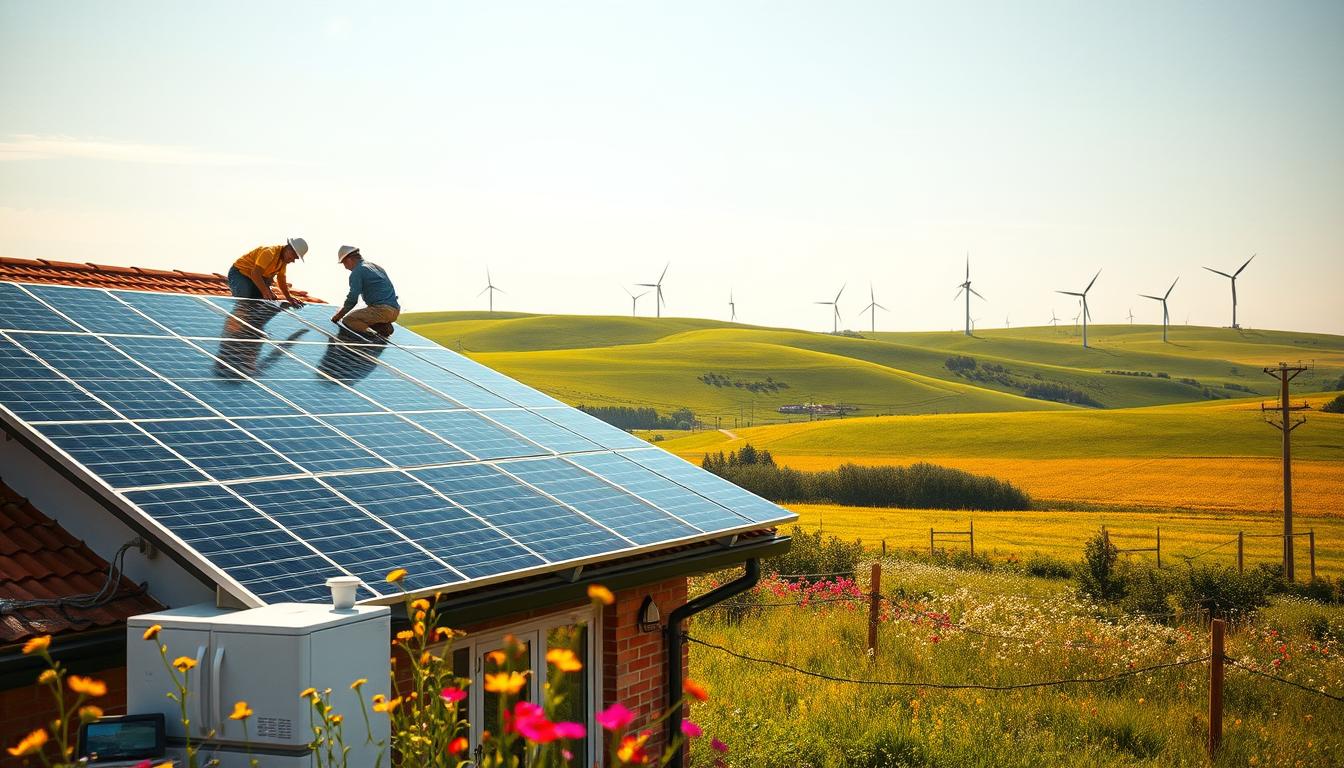
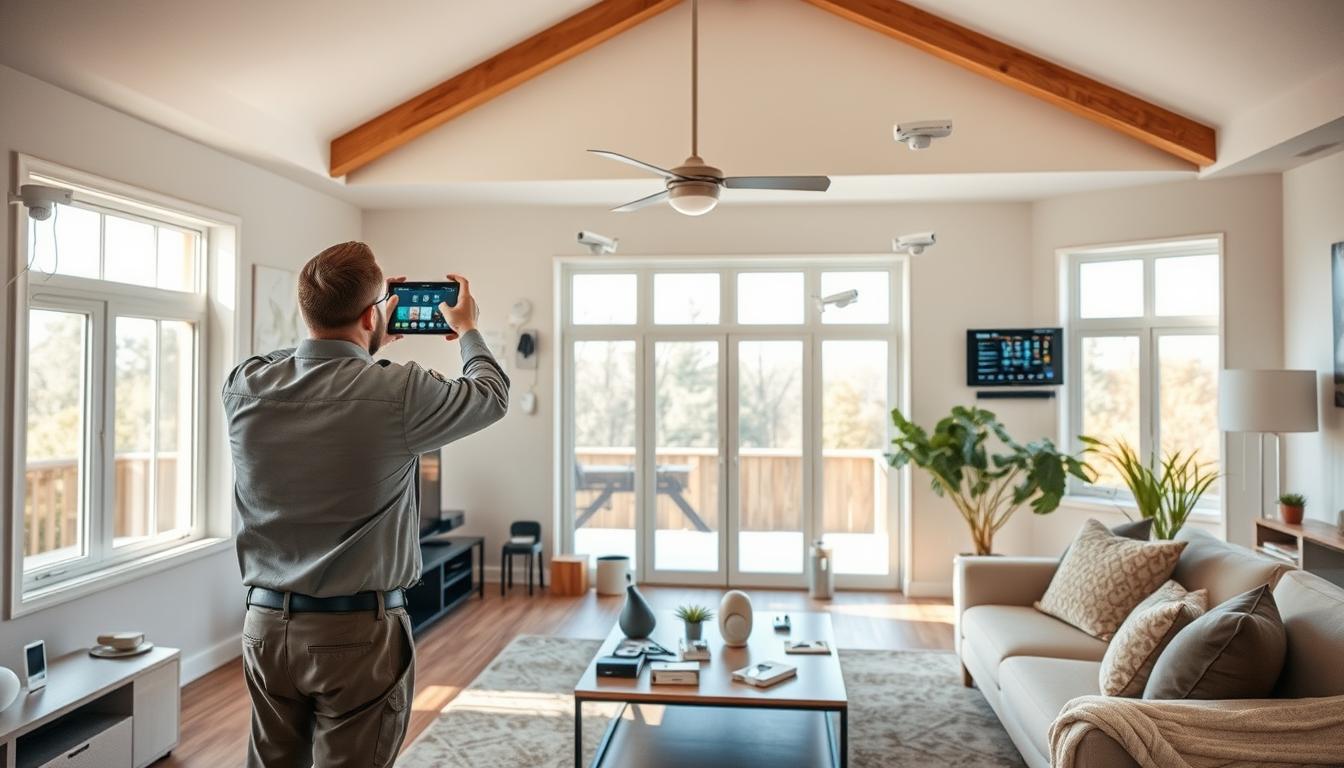
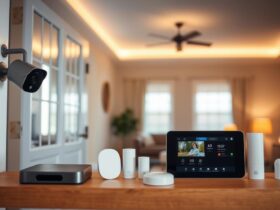
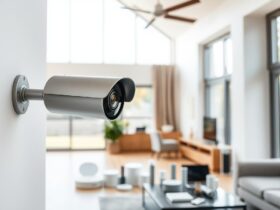
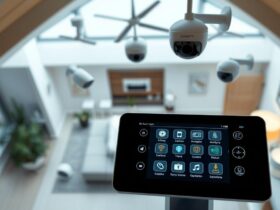
Leave a Reply